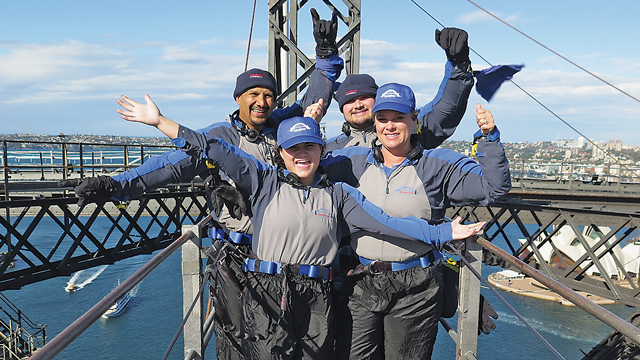Kaitlyn Vargas was a young child when she first saw images of Australia in books and on television. Ever since then, she’s dreamed of visiting the country to explore its wonder. “It seemed like such an amazing place,” she said. “But seeing it on the Discovery Channel, it didn’t seem real. It didn’t seem real until I was there.”
Kaitlyn and her family traveled from their Chesterfield County home to Australia last May through Make-A-Wish Greater Virginia. They stayed for a week, giving them plenty of time to visit the Taronga Zoo, snorkel inside an aquarium, and climb the Sydney Harbour Bridge. “I even tried schnitzel and shepherd’s pie,” said Kaitlyn, a freshman at Virginia Commonwealth University. “I got to snuggle with a kangaroo and pet a koala bear. It was so cool. It’s something I never thought I would be able to do.”
Kaitlyn, eighteen, was diagnosed with cystic fibrosis when she was two months old. While life has never been easy, she said, she never considered herself a Make-A-Wish kid. “When I thought of Make-A-Wish, I thought of younger kids battling cancer,” she said. “I never thought of myself as being sick.”
 The Make-A-Wish Foundation grants the wishes of children diagnosed with life-threatening medical conditions. With sixty-two chapters in the United States, Puerto Rico, and Guam, the nonprofit organization has granted more than 270,000 wishes since its inception in 1980.
The Make-A-Wish Foundation grants the wishes of children diagnosed with life-threatening medical conditions. With sixty-two chapters in the United States, Puerto Rico, and Guam, the nonprofit organization has granted more than 270,000 wishes since its inception in 1980.
“A lot of people think ‘life-threatening’ means terminal,” said Sheri Lambert, president and CEO of Make-A-Wish Greater Virginia. “That’s not the case. Life-threatening means progressive, degenerative, or malignant. We know the impact a wish has on these children. It gives them a sense of normalcy.”
For Kaitlyn’s family, that sense of normalcy came in Sydney at the top of Harbour Bridge.
“To see your child so happy, your worries go away – even if it’s just for a little while,” said Kaitlyn’s mother, Kimberly Vargas. “While we were up there, we could just breathe. We could just be. We are so grateful.”
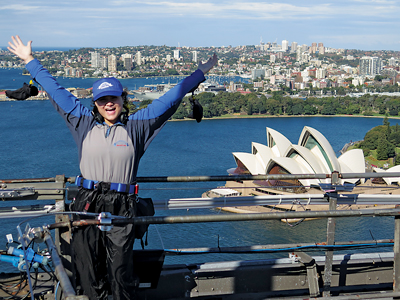 While Kaitlyn’s wish has been fulfilled, she and her family know there are many more children with many more wishes that have not yet been realized. That is why Kaitlyn, her mother, her father, Isaias, and brother, Tyler, continue to volunteer with the organization. Kaitlyn currently serves as the co-chair for Walk for Wishes, an annual 2-mile walk at Stony Point Fashion Park that raises funds for the organization. “It’s not over just because my wish was granted,” Kaitlyn said. “I want to help other children realize their wishes, too. It’s important to give back, no matter the cause.”
While Kaitlyn’s wish has been fulfilled, she and her family know there are many more children with many more wishes that have not yet been realized. That is why Kaitlyn, her mother, her father, Isaias, and brother, Tyler, continue to volunteer with the organization. Kaitlyn currently serves as the co-chair for Walk for Wishes, an annual 2-mile walk at Stony Point Fashion Park that raises funds for the organization. “It’s not over just because my wish was granted,” Kaitlyn said. “I want to help other children realize their wishes, too. It’s important to give back, no matter the cause.”
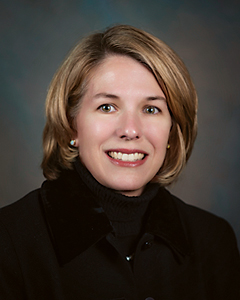
The family also donates their time to the Virginia Chapter of the Cystic Fibrosis Foundation. They started Team Kaitlyn to raise money for the annual Richmond Great Strides walk and volunteer at other fundraising events, including car washes and the annual Richmond’s Finest and Brewer’s Ball. Kaitlyn has been an ambassador for the foundation since the second grade.
“Kaitlyn is a wonderful person,” said Terri Quinan, executive director for the Virginia Chapter of the Cystic Fibrosis Foundation. “Volunteers like her are so critical in helping us raise awareness about cystic fibrosis and show how hard they are fighting to beat the devastating effects of this disease.”
With about 30,000 cases in the United States and 880 in Virginia, CF is both rare and complex. It is a progressive, genetic disease that causes persistent lung infections and limits the ability to breathe over time. In people with CF, a defective gene causes a thick buildup of mucus in the lungs, pancreas, and other organs. “Everybody knows someone who has been affected by cancer, diabetes, or heart disease,” Quinan said. “But because CF is so rare, it is relatively unknown.”
It is also a very lonely disease. The CF Foundation recommends that only one person with CF be in a building at a time. When outside, CF patients are encouraged to stay at least six feet away from each other to protect them from cross-contamination.
“It can be so depressing to see your friends sick,” Kaitlyn said. “We each know what the other
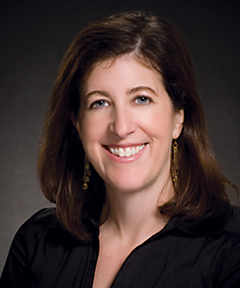
is going through, but we can only talk on the phone or through social media. It is sometimes overwhelming to deal with it all.”
Kaitlyn takes about forty pills a day, including enzymes that help her body process nutrients and maintain a clear airway. She hooks herself up to a therapy vest twice a day. This device shakes her, breaking up the mucous in her chest. “It can seem like a lot to most people, but honestly, it’s become second nature to me,” said Kaitlyn, a former competitive gymnast. “It’s all I’ve ever known. My friends are so supportive.”
At sixteen, Kaitlyn was diagnosed with CF-related diabetes. Now she has one more thing to worry about. She must monitor her blood sugar levels and take insulin injections. “My hardship is no different than anyone else’s,” she said. “I can’t sit here and feel sorry for myself. You have to live your life to the fullest.”
That’s the hope of the CF Foundation. Its mission is to cure CF and to provide all people with the disease the opportunity to lead full, productive lives by funding research and drug development, promoting individualized treatment, and ensuring access to high-quality, specialized care.
“We are the most exciting thing in medicine today because of the progress we’ve made and where we are going,” Quinan said. “We’ve been aggressive and kept our eye on the prize – finding a cure.”
The foundation funds more innovative, groundbreaking CF research and drug development than any other organization in the world, investing hundreds of millions of dollars in the cause. The results, Quinan said, “have been astonishing.”
When the organization was established in 1955, people born with CF weren’t
expected to live to attend elementary school. Today, the life expectancy has reached forty.
“That’s still way too young, but we are making great progress,” Quinan said. “This is no longer a pediatric disease. We’ve had incredible results because of what we have been able to develop.”
For example, in 2012, the FDA approved the drug Kalydeco for people six and older with the G551D mutation of the CF gene. The drug is the first to address the underlying cause of CF by treating the genetic defect on a cellular level.
And in 2015, the FDA approved the lumacaftor/ivacaftor combination drug (Orkambi) for people twelve and older who have two copies of the most common CF mutation, F508del. This represents about a third of those with CF in the United States.
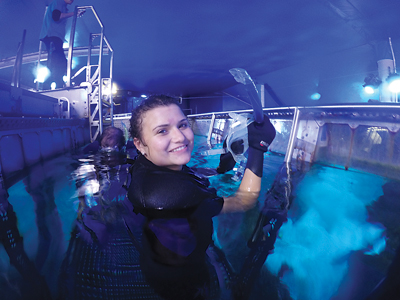 “We have funded and developed nine drugs or therapies out on the market right now,” Quinan said. “And we have a great drug pipeline that targets the disease from every angle. We’ve had some major advances, with more to come. I really believe that we will see a cure for CF in
“We have funded and developed nine drugs or therapies out on the market right now,” Quinan said. “And we have a great drug pipeline that targets the disease from every angle. We’ve had some major advances, with more to come. I really believe that we will see a cure for CF in
the next two to three decades.”
While Kaitlyn remains optimistic as well, she’s not counting on anything.
“I take every day one day at a time,” she said. “You can’t just sit back and hope for a cure. You have to get out there and live your life. You have to fight!”
Kaitlyn is doing just that by adhering to her strict treatment regimen, eating healthy, and working out at the gym regularly. Just as vital, she said, is continuing her volunteer work with the CF Foundation and Make-A-Wish.
“Without our volunteers, we would not be able to do all that we do at Make-A-Wish,” Lambert 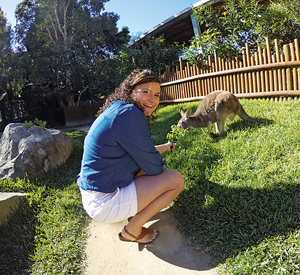 said. “Kaitlyn is right in there. She is an incredibly focused, determined young lady.”
said. “Kaitlyn is right in there. She is an incredibly focused, determined young lady.”
About 400 volunteers help the Virginia chapter with fund-raising events and awareness. More than half serve as wish-granters, coordinating the logistics of each child’s wish.
Most wishes – about 80 percent – fall in the “I wish to go somewhere” category, Lambert said. The foundation has organized trips all over the world, including Hawaii, Costa Rica, and Switzerland. Other popular wishes include meeting someone famous, wanting something like a puppy, or being something for a day, like a princess or a Marine.
“The power of the wish is incredible,” Lambert said. “Children are often more willing to comply with their treatment protocol because it gives them something special to look forward to.”
Now that her wish has been realized, Kaitlyn plans to become a wish granter when her duties as co-chair for Walk for Wishes are complete.
“Giving back is one of the most important things we can do in this life,” Kaitlyn said. “It makes my soul happy.”
The CF Foundation is also near and dear to Kaitlyn’s heart.
“Unfortunately, they are not well known,” she said. “It’s so important for people to learn about this organization and what it is doing. I’ll tell anyone who will listen.”
The local chapter, established in 1955, has about 3,000 volunteers who help organize ten awareness walks across the state each year. In addition to the Finest and Brewer’s Ball, the group also holds the Xtreme Hike, the Starry Night Gala, and other events.
“We began volunteering with the foundation when we lived in California,” Kimberly Vargas said. “When we moved to the Richmond area in 2009, we knew we wanted to keep it going.”
Not only does the foundation raise funds for cure research and treatment, but it helps families who can’t afford their medications. In 2015, the national Cystic Fibrosis Foundation raised $123 million.
“And it offers support groups, connecting families to each other and the resources they need,” Kimberly Vargas said. “Having that support – knowing you have someone else out there who is going through the same thing you are – is invaluable. We are all fighting together for the same goal. We want CF to stand for ‘cure found.’”
For Kaitlyn, the fight grows more personal each day as she meets more people battling right alongside her. She sees some give up, while others grow more committed to raising awareness.
“I have friends who are married and living full lives,” she said. “That’s what I want, too. I see others who give up. That is so hard to watch. I tell them, ‘Keep your head held high. Keep fighting. If you give up, we all lose.’ I don’t ever want to quit. I have big plans.”
After college, Kaitlyn hopes to work as a counselor, helping young people who are battling not just CF, but any chronic illness.
“Sometimes it can feel like the world is crashing down,” she said. “I get that. I understand it. But I know that’s not the way I want to live, or want others to live. There’s too much to live for.”
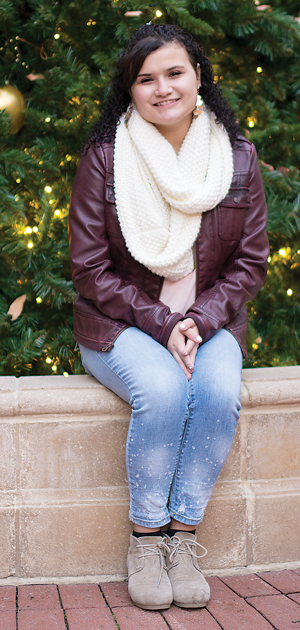 Did You Know?
Did You Know?
There are more than 1,700 mutations of the cystic fibrosis gene. Some are common and others are rare and found only in a few people. People with CF have inherited two copies of the defective CF gene – one copy from each parent. Both parents must have at least one copy of the defective gene. People with only one copy of the defective CF gene are called carriers, but they do not have the disease. Each time two CF carriers have a child, the chances are 25 percent that the child will have CF.
According to the Cystic Fibrosis Foundation:
• More than 30,000 people are living with cystic fibrosis in the United States.
• Approximately a thousand new cases of CF are diagnosed each year.
• More than 75 percent of people with CF are diagnosed by age two.
• More than half of the CF population is age eighteen or older.
• Newborn screening for CF is performed in all fifty states.


